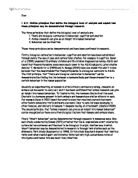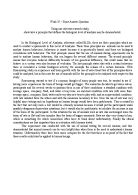Our next principle states that ‘Humans are social animals and have a social self.’ People not only have a personal identity but also a collective or social one. Social identity is a person’s sense of who they are based on their group membership. Tajfel proposed that the groups (e.g. social class, family, football team etc.) which people belonged to were an important source of pride and self-esteem. Identification with and membership of a group give us a social identity: a sense of belonging to the social world. Our thinking and behaviour may be strongly influenced by membership of a group. In 1970 tajfel conducted a study to demonstrate that merely putting people into groups is enough for people to discriminate in favour of their own group and against members of the other group. The study consisted of a laboratory experiment. The subjects were 64 boys, 14 and 15 years old from a comprehensive school in a suburb of Bristol. The boys were informed that they would be divided into groups such as “over-estimators” or “under-estimators” according to the results of visual test. In fact, they were randomly grouped. Later participants were asked to do a task where they had to allocate reward and penalty points to other boys, both in-group and out-group. Each boy was tested in isolation. The boys were told that they cannot allocate points to themselves and would not know the identity of the individuals to whom they would be assigning these rewards and penalties since everyone would be given to a number code. The results showed that within the same groups, fairness was displayed. When points had to be allocated to members of two different groups at the same time, boys tend to give more points to the boy in their group. Randomly categorizing boys into meaningless groups, in-group bias and out-group discrimination was shown. This means that bias and discrimination against the out-group comes automatically in any group situation without any competition or hostility but simply from categorization. Lastly, the results also show that the process of categorization oneself into a group gives a distinct meaning to the individual’s behavior, therefore creating a positive valued social identity. However this study is artificial as in it lacks ecological validity as in everyday life categorization does come with its certain amount of competition. There is a possible interpretation bias here as although the boys showed bias towards their own group, this bias was not very extreme and seemed to be moderated by a sense of fairness. A major strength of the procedure was the high level of control Tajfel managed to employ. For example, there was no face-to-face interaction between group members; the boys only knew of other in-group/out-group members by a code number. And we must also look at the ethical considerations as the students were debriefed after the experiment.
In an ever more multi-cultural society there is a need to understand the effect of culture on a person’s behavior, because the study of culture may help us understand and appreciate cultural differences better. Thus we talk about the third principle of SCLOA that is culture influences behavior. To prove this right a study was conducted by Yuki et al. in 2005.the aim of this study was to determine if people automatically categorized themselves and favor in their groups across cultures. The experiment was to compare U.S. and Japanese university student in three scenarios. Subjects were 171 male and female from Ohio State University, 171 male and female from Hokkaido University students and 28 male and female Hokkaido Education University students. Three scenarios were used: first, someone is from an in-group; second, someone is from out-group with potential but no actual connection between the out-group members through the participants’ acquaintance; third, someone is from out-group that suggested with no potential connection. The questionnaires were given to participants about asking someone to watch luggage in an airport, allowing someone to borrow money at a restaurant, and buying concert tickets online from an individuals. Later they were told to decide which person you would trust from any of the scenarios defined above. The results are U.S and Japanese participants trusted the unknown person from the in-group more than they trusted either out-group person. In addition, the Japanese sample was more likely to trust the out-group member with potential connection. In contrast, the U.S. sample did not trust either out-group member, even if the person had a potential connection. Yuki suggested that participants had different reason for trusting groups because of their cultures and different views. The Americans have a more independent thought process, whereas the East Asians have a more community oriented culture.Yuki had good controls over the experiment and is very well standardized as there is an equal distribution of gender and could be generalized to other cultures. It had high ecological validity and could be very well replicated and applicable to the real world .The students were debriefed after the experiment was conducted and the deception in the starting of the experiment although unethical was required as the students knowing the true aim of the experiment would have brought about a bias in the results. Although this study can be replicated one must criticize how applicable this study could be to different age groups as only university students were used.
The last principal which is important at this level of analysis that will be talked about is people’s views of the world are resistant to change. People always tend to adapt to change but never accept it graciously. Hence there is always dissidence towards it. One of the most well known covert observations carried out by Leon Festinger and his colleagues in 1956. In Chicago, there was a religious cult that believed the world would end on 21st December. They believed that when the natural catastrophes began, they would be rescued by flying saucers as long as they followed prescribed rituals and read the sacred texts . Festinger and his team decided to become cult members in order to carry out a participant observation. They remained with the cult up to the fateful day of 21st December but when nothing happened, the group members began to doubt, debate and rationalize what had just occurred. In order to save their self esteem they concluded that God had not destroyed the world thanks to their prayers. Festingers had heavily biased the results of this study as infiltration of 5 members in this small group lead the true believers to firm up their own thoughts and brought about more commitment to their cause than they usually might have had. Through further research of this study we see that many people who part took in this study had their careers ruined and were threatened of being institutionalized raises many ethical issues relating to confidentiality of this study and physical and psychological harm to the participants. Having used an observational research study Festingers control over the study and its variables are very less. The small number of participants used shows minimal representation of the whole population and hence cannot be standardized or cross culturally generalized. To prevent this Festinger should have used fewer number of infiltrators and should not have directly participated in the cult . As there could have been a researchers bias as he could have taken into account only what he wanted in order to get the results he wished for.
Finally, In conclusion The socio-cultural level looks at behavior as dependent upon the current situation or circumstances i.e. events external to the individual. The principles focusing SCLOA prove that social and cultural environment influence individuals and people construct their own assumptions of themselves and their social identities . With the help of some famous studies, each principle has been broken down to help in depth understanding of SCLOA .And thus it is seen, that people want connectedness with, and a sense of belonging to, others and this is a necessity for our survival
Tanisha Sabhaney








